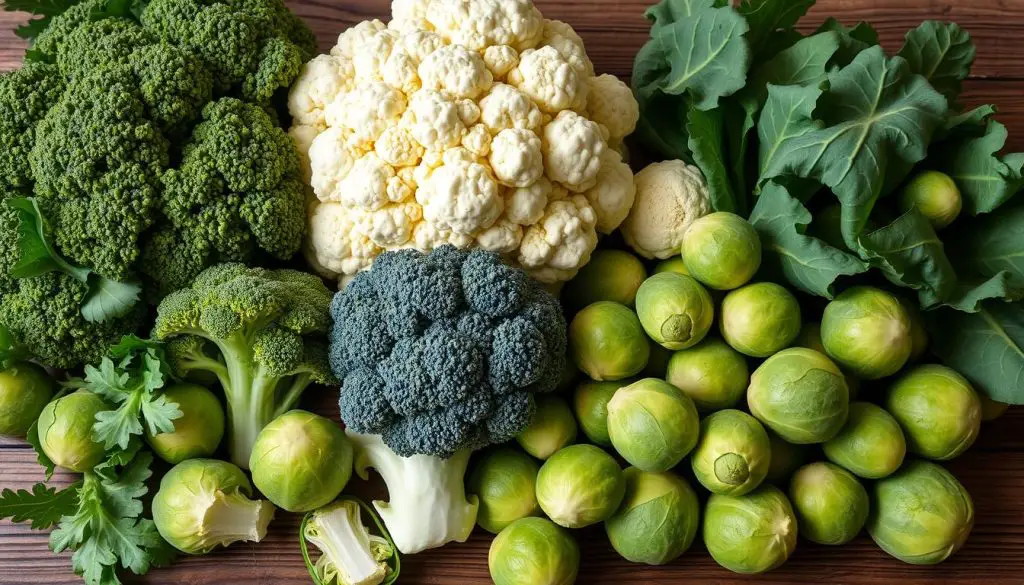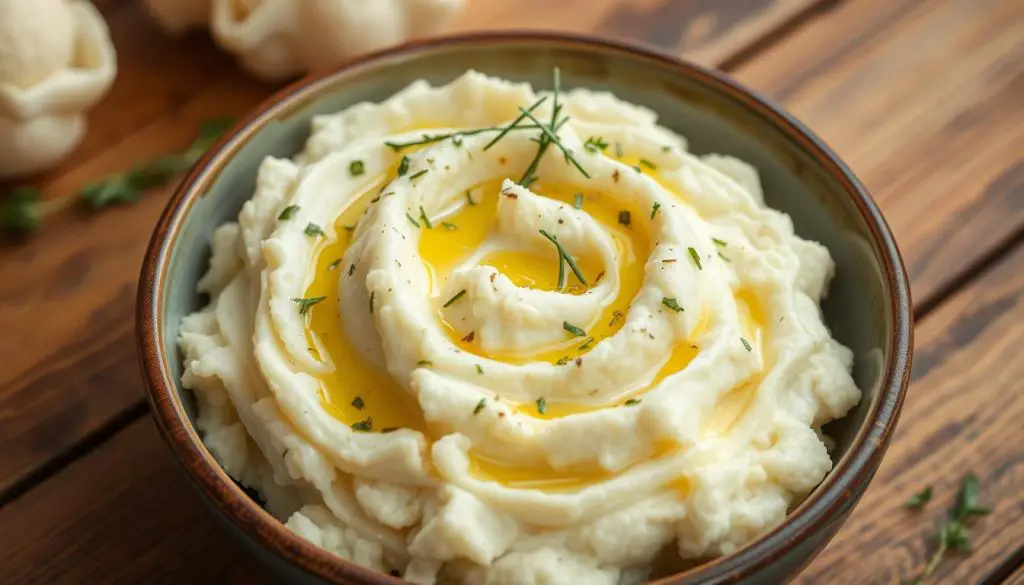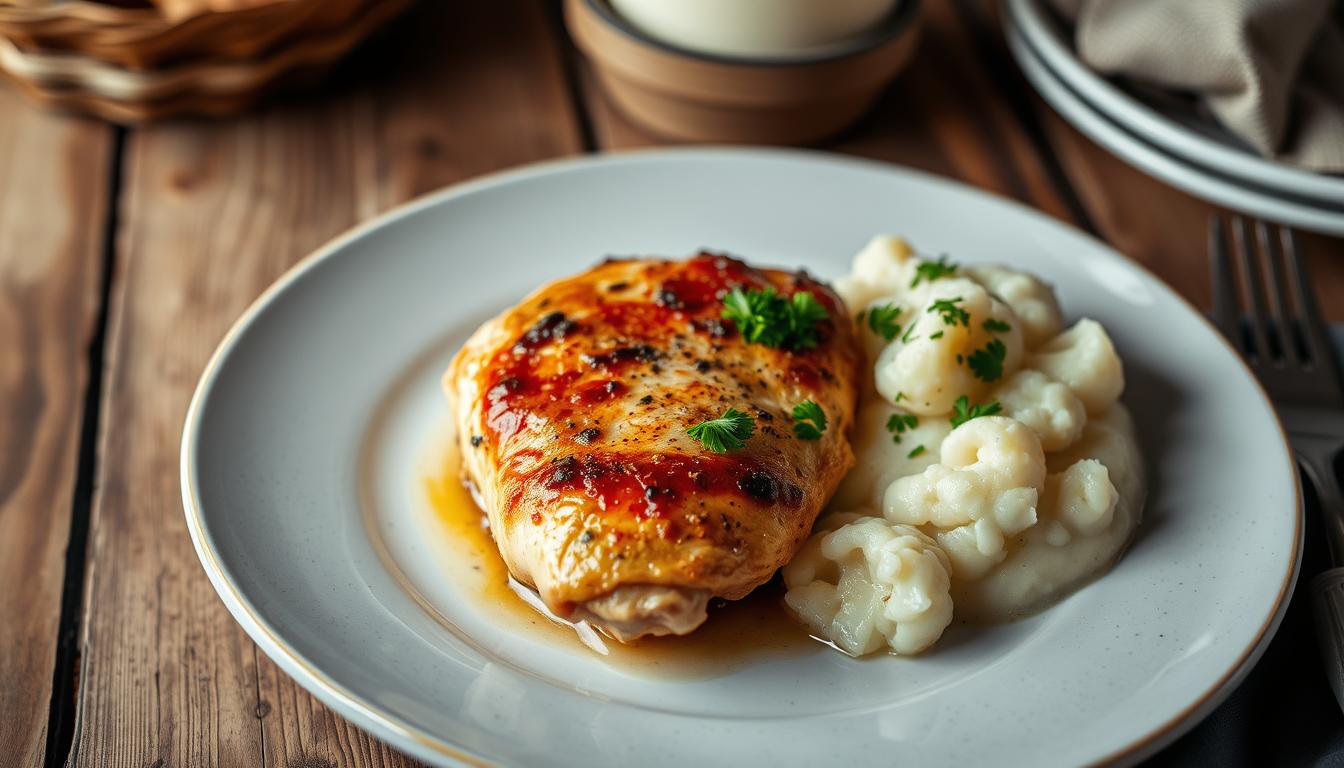Are you tired of living with fibromyalgia’s constant pain and tiredness? The answer might be in your kitchen. Try baked chicken with mashed cauliflower. It’s tasty and packed with nutrients that fight inflammation and boost your health.
Did you know cauliflower is super low in calories? A cup has just 25 calories and 5 grams of carbs. It’s also rich in vitamin C, with 77% of what adults need in one cup. Cauliflower is a nutritional powerhouse.
This veggie is full of good stuff like vitamin K, fiber, and protein. It even has omega-3 fatty acids and potassium. Eating cauliflower can help you feel better and manage fibromyalgia symptoms. The American Heart Association says we should eat 25 to 30 grams of fiber a day. Cauliflower gives you almost 10% of that in one serving.
What is a Fibromyalgia-Friendly Diet?
For those with fibromyalgia, a balanced anti-inflammatory diet can greatly help. It focuses on foods that fight inflammation and support the body. This can lead to better pain management and more energy.
Anti-Inflammatory Foods for Managing Chronic Pain
Eating anti-inflammatory foods daily can ease fibromyalgia pain. Good choices include:
- Leafy green vegetables
- Berries and other colorful fruits
- Fatty fish like salmon, mackerel, and sardines
- Nuts and seeds
- Turmeric, ginger, and other anti-inflammatory spices
These foods are packed with nutrients and can help reduce pain.
Nutrient-Dense Meals for Improved Energy Levels
Choosing meals rich in nutrients is also key. Foods with vitamins, minerals, and healthy fats are great. They include:
- Whole grains like quinoa, brown rice, and oats
- Lean protein sources such as chicken, turkey, and legumes
- Healthy fats from avocados, olive oil, and nut butters
- Nutrient-dense vegetables like sweet potatoes, broccoli, and spinach
These meals can help fight fatigue and boost energy in fibromyalgia patients.
| Anti-Inflammatory Foods | Nutrient-Dense Foods |
|---|---|
| Leafy greens, berries, fatty fish, nuts, and spices | Whole grains, lean protein, healthy fats, and nutrient-dense vegetables |
By eating an anti-inflammatory diet and choosing nutrient-dense meals, fibromyalgia patients can better manage pain. They can also improve their energy and overall health.
Baked Chicken with Mashed Cauliflower for Fibromyalgia
If you have fibromyalgia, eating a diet friendly for fibromyalgia can really help. A great choice is baked chicken with mashed cauliflower.
Baked chicken is full of lean protein, which is good for muscles and health. Cauliflower is anti-inflammatory, which helps with fibromyalgia symptoms.
This recipe is not just good for you, but it’s also comforting. The mix of tender baked chicken and creamy mashed cauliflower tastes great and meets your dietary needs.
| Ingredient | Quantity |
|---|---|
| Boneless, skinless chicken breasts | 4 (approx. 1 lb) |
| Cauliflower florets | 1 medium head (approx. 4 cups) |
| Olive oil | 2 tbsp |
| Garlic powder | 1 tsp |
| Dried thyme | 1 tsp |
| Salt and black pepper | to taste |
| Unsweetened almond milk | 1/4 cup |
| Parmesan cheese (optional) | 2 tbsp |
Adding this baked chicken with mashed cauliflower to your diet can be a game-changer. It’s a tasty, healthy meal that might ease your symptoms and boost your health.
Lean Protein Sources for Fibromyalgia
Incorporating lean protein into your diet can greatly help with fibromyalgia. Chicken is a top choice because it’s easy to find and digest. It supports muscle function and recovery, which is key for those with fibromyalgia.
Benefits of Chicken for Chronic Pain Management
Chicken is packed with amino acids, which help repair muscles and reduce inflammation. It’s also low in fat and calories, making it great for managing weight and symptoms of fibromyalgia.
- Chicken is a lean protein that is easy to digest and can support muscle function and recovery.
- The amino acids in chicken can help reduce inflammation, which is a key factor in managing chronic pain associated with fibromyalgia.
- Incorporating chicken into a balanced, anti-inflammatory diet can be beneficial for individuals with fibromyalgia.
Adding lean proteins like chicken to your diet can help your body heal naturally. It may also lessen some of the tough symptoms of fibromyalgia.
Cruciferous Vegetables and Fibromyalgia
If you have fibromyalgia, adding cruciferous vegetables to your diet can change your life. These veggies, like cauliflower, are packed with antioxidants and vitamins. They help fight inflammation, which can ease fibromyalgia symptoms.
Cruciferous veggies are great for detoxing your body. They contain sulforaphane, which boosts your body’s detox system. This helps remove toxins that can make fibromyalgia worse.
These veggies are also full of vitamins and minerals. Cauliflower, for example, is rich in vitamin C. Vitamin C boosts your immune system and helps with collagen production, important for connective tissues.
Adding cruciferous vegetables to your meals is easy. Try roasting cauliflower with olive oil and garlic powder. Or blend them into a creamy mashed “potato” dish. There are many ways to enjoy them, and they can help manage fibromyalgia symptoms.

A fibromyalgia-friendly diet is key to managing this condition. By eating more cruciferous vegetables, you can improve your life and reduce fibromyalgia’s impact on your daily activities.
Gluten-Free Cooking for Fibromyalgia
If you have fibromyalgia, a gluten-free diet might help manage your symptoms. Gluten, found in wheat, barley, and rye, can cause inflammation. This can make fibromyalgia’s chronic pain and fatigue worse.
Alternatives to Wheat and Grains
There are many gluten-free options to replace wheat and grains. Some healthy choices include:
- Cauliflower rice – A nutritious substitute for regular rice or grains.
- Quinoa – A gluten-free, protein-rich pseudo-grain for various dishes.
- Almond flour – A nut-based flour for baking gluten-free breads and muffins.
- Coconut flour – A high-fiber nut-based flour to replace wheat flour in recipes.
Using these gluten-free alternatives in your meals can make your diet both tasty and healthy. It’s perfect for a fibromyalgia-friendly diet.
For successful gluten-free cooking with fibromyalgia, try different ingredients. Find what works best for you and your taste. With creativity, you can make meals that are good for your body and taste great.
Low-Inflammatory Meal Preparation Techniques
Managing fibromyalgia can be helped by how you cook your meals. Using low-inflammatory cooking methods can make your food both tasty and healthy. This way, you can meet your dietary needs while feeling better.
High-heat cooking like frying can harm your health by causing inflammation. Instead, try baking, steaming, and sautéing. These methods keep your food’s natural taste and nutrients. They also reduce harmful compounds that cause inflammation.
- Baking is great for cooking lean proteins and roasting veggies. It brings out their sweetness and boosts their health benefits.
- Steaming helps keep nutrients in veggies, grains, and proteins. It’s a good way to cook without losing important vitamins and minerals.
- Sautéing with a bit of healthy oil like olive or avocado oil is good. It cooks food quickly without losing its nutritional value.
Using these low-inflammatory cooking techniques can make your meals more nourishing. They help your body recover and manage fibromyalgia symptoms better.

The Role of Diet in Fibromyalgia Management
Fibromyalgia is a chronic condition that affects many people, mostly women. Research shows diet might help manage its symptoms. Eating anti-inflammatory, nutrient-rich foods can reduce pain, boost energy, and control symptoms.
A study in the Scandinavian Journal of Rheumatology found a vegan diet helped fibromyalgia patients. They saw a 30% drop in pain points and needed less painkillers. Some patients also improved by avoiding MSG and aspartame.
Dietary changes can be very helpful for fibromyalgia. Almost half of all fibromyalgia patients try dietary changes, finding it beneficial. Over 70% of CFS/ME patients also find diet helpful.
A good fibromyalgia diet includes vegetables, fruits, whole grains, lean proteins, and healthy fats. Avoiding processed foods, added sugars, and omega-6 fats can also help. These foods reduce inflammation and ease symptoms.
Managing fibromyalgia also involves medication, exercise, and stress management. Combining these strategies can improve health and quality of life.
More research is needed to fully understand diet’s role in fibromyalgia. But, current evidence supports an anti-inflammatory diet. Working with healthcare professionals, individuals can find dietary changes that help manage symptoms and improve well-being.
Fibromyalgia-Friendly Recipe: Baked Chicken
Ingredients
Making a tasty baked chicken dish that’s easy on your body is simple. Here’s what you’ll need:
- 4 chicken breast fillets
- 1/4 tsp sea salt
- 1/4 tsp black pepper
- 1 tbsp coconut oil
- 1/2 red onion, chopped
- 1 cup chicken stock
- 2 tbsp lime juice
- 1 tbsp fresh parsley, chopped
- 1 whole red chili, finely sliced (optional)
- 1/2 tsp red chili flakes (optional)
- 1/2 cup coconut milk or coconut cream
Instructions
Here’s how to make this baked chicken recipe that’s good for your body:
- Flatten the chicken breasts and season them with salt and pepper.
- Heat the coconut oil in a skillet and brown the chicken on both sides.
- Sauté the chopped onion in the same skillet until translucent.
- Add the chicken stock, lime juice, parsley, and optional chili and chili flakes to the skillet.
- Simmer the sauce for about 10 minutes, letting the flavors mix.
- Stir in the coconut milk or coconut cream for a creamy sauce.
- Serve the baked chicken with cauliflower rice or your favorite side dish.
- Garnish with more parsley and chili slices, if you like.
Enjoy this tasty and fibromyalgia-friendly baked chicken recipe. It’s full of ingredients that help fight pain and support your health.
Fibromyalgia-Friendly Recipe: Mashed Cauliflower
For those with fibromyalgia, finding recipes that are both nutritious and anti-inflammatory is key. Our mashed cauliflower dish is a great option. It’s creamy and comforting, making it a perfect side for our baked chicken. It also offers extra benefits for your health.
Ingredients:
- 1 large head of cauliflower, cut into florets
- 1/4 cup unsweetened almond milk
- 2 tablespoons grass-fed butter or olive oil
- 1 teaspoon garlic powder
- 1/2 teaspoon sea salt
- 1/4 teaspoon black pepper
Instructions:
- Boil a few inches of water in a large pot. Add the cauliflower florets and cook for 15-20 minutes, until tender.
- Drain the cauliflower and put it back in the pot. Add almond milk, butter or olive oil, garlic powder, salt, and pepper. Mash until smooth.
- Taste and adjust the seasoning if needed. Serve hot, with fresh herbs or paprika on top, if you like.
This mashed cauliflower recipe is a great way to add anti-inflammatory, fibromyalgia-friendly ingredients to your meals. Enjoy this creamy, tasty side dish as part of a balanced diet. It helps support your overall health and manage fibromyalgia symptoms.

Meal Planning for Fibromyalgia
For those with fibromyalgia, meal planning is key. It helps you eat foods that fight inflammation and are full of nutrients. Adding fibromyalgia-friendly foods to your meals can help your body heal and reduce pain.
Begin by batch cooking and meal prepping your meals early. This saves time and keeps you eating healthy, anti-inflammatory foods all week. Try roasting a big batch of chicken or salmon for various dishes. Or make a big vegetable-based soup that’s easy to reheat.
When planning your meals, choose foods that are nutrient-dense. This means foods like:
- Leafy greens
- Cruciferous vegetables
- Omega-3-rich fish
- Anti-inflammatory spices and herbs
- Probiotic-rich fermented foods
These foods help lower inflammation and give your body the vitamins and minerals it needs.
Also, add gluten-free and low-glycemic foods to your plans. They help keep your blood sugar stable and reduce inflammation. Try quinoa or brown rice instead of regular grains. Look for fiber-rich veggies as sides instead of starchy foods.
By planning and preparing your meals, you fuel your body with the right foods. This helps manage your fibromyalgia symptoms well.
Healthy Lifestyle Tips for Fibromyalgia
Exercise, Stress Management, and Sleep Hygiene
Living with fibromyalgia means taking care of your health is key. Eating well, like a fibromyalgia-friendly diet, is important. But, regular exercise, managing stress, and good sleep habits can make a big difference too.
Exercise helps by cutting down pain, improving sleep, and giving you more energy. Try low-impact activities like walking, swimming, or gentle yoga. Start slow and build up your routine to avoid getting too tired.
Managing stress is also critical. Try meditation, deep breathing, or muscle relaxation to handle stress better. Joining supportive groups and doing relaxing activities can also help.
Good sleep habits are essential too. Stick to a sleep schedule, make your bedroom comfy, and avoid screens before bed. This can lead to better sleep and help manage fibromyalgia symptoms.
By making these healthy habits part of your daily life, you can manage your fibromyalgia better. This can greatly improve your quality of life.

| Healthy Lifestyle Factors | Benefits for Fibromyalgia |
|---|---|
| Regular Exercise | Reduced pain, improved sleep, increased energy |
| Stress Management | Decreased intensity of flare-ups, enhanced well-being |
| Proper Sleep Hygiene | Better sleep quality and duration, improved symptom management |
Finding Support for Fibromyalgia
Living with fibromyalgia can be tough, but you don’t have to face it alone. There are many resources and support groups ready to help. They can make your journey easier and improve your life.
Joining a fibromyalgia support group is a great step. These groups offer a safe space to meet others who understand what you’re going through. You can share your experiences, learn new ways to cope, and find comfort in a community that gets it.
- Look for local fibromyalgia support groups to find meetings and connect with others.
- Check out online forums and social media groups for a wider network of people with fibromyalgia.
- Attend virtual or in-person events and workshops on managing fibromyalgia and staying well.
There’s also a lot of helpful information and resources from trusted organizations and websites. These places offer the latest research, tips for managing symptoms, and help with the healthcare system.
- Visit the websites of groups like the American College of Rheumatology, the National Fibromyalgia Association, and the Arthritis Foundation for lots of fibromyalgia resources.
- Subscribe to newsletters or follow these organizations on social media to stay updated.
- Use online directories to find local healthcare providers, therapists, and experts in fibromyalgia management.
Remember, you’re not alone in your fight against fibromyalgia. By connecting with the fibromyalgia community and using the available resources, you can get the support and information you need. This will help you manage your condition better and improve your life overall.
Frequently Asked Questions About Fibromyalgia Diet
If you have fibromyalgia, you might wonder how diet affects your symptoms. Let’s tackle some common questions. This will help you understand how nutrition can help manage this chronic condition.
What dietary changes should I make for fibromyalgia? Focus on eating anti-inflammatory foods like lean proteins, fruits, veggies, whole grains, and healthy fats. Also, try to avoid processed foods, sugar, and gluten to help ease symptoms.
Is there a specific “fibromyalgia diet” I should follow? There’s no single diet for everyone with fibromyalgia. But, a diet rich in whole foods and plants, with fewer processed items and allergens, is often best. Experiment to find what works best for you.
How soon will I see improvements from diet changes? Everyone is different, but many notice better pain, fatigue, and symptoms in a few weeks. Be patient and keep trying until you find the right diet for your body.
Source Links
- https://perfectketo.com/is-cauliflower-keto/
- https://www.healthline.com/health/rheumatoid-arthritis/seven-day-meal-plan
- http://ndl.ethernet.edu.et/bitstream/123456789/36842/1/3125.pdf
- https://www.beingfibromom.com/monthly-meal-plans-april-2017/
- https://www.verywellhealth.com/leaky-gut-diet-4773680
- https://findinglifessilversun.com/tag/fibromyalgia/
- https://fightingfibrowithfire.com/
- https://www.healthline.com/nutrition/50-super-healthy-foods
- https://www.healthline.com/health/low-fiber-diet
- https://www.fibrofix.com/pages/21-day-detox
- https://www.healthline.com/health/ulcerative-colitis/what-vegetables-can-i-eat-with-ulcerative-colitis
- https://unboundwellness.com/nightshades/
- http://caseythecollegeceliac.blogspot.com/2020/04/57-easy-gluten-free-dinner-recipes-for-family.html
- https://sevenlayercharlotte.com/2018/11/01/notes-from-the-gluten-free-dairy-free-class/
- https://www.christinebailey.co.uk/wp-content/uploads/2021/03/Lectin-recipes.pdf
- https://www.healthline.com/nutrition/low-carb-diet-meal-plan-and-menu
- https://www.weightandwellness.com/resources/podcasts/food-prep-go-ask-nutritionist
- https://health.clevelandclinic.org/anti-inflammatory-diet-can-relieve-pain-age
- https://mammachefjozi.com/coconut-lime-chicken-low-carb-cauliflower-rice/
- https://fightingfibrowithfire.com/tag/fibromyalgia/
- https://www.healthrising.org/blog/2013/09/23/glycemic-index-diet-right-chronic-fatigue-syndrome-fibromyalgia/
